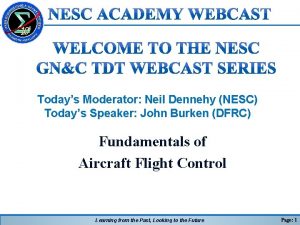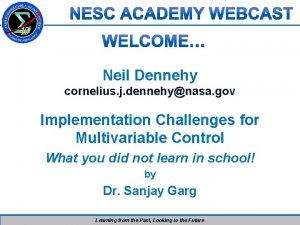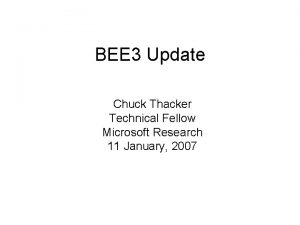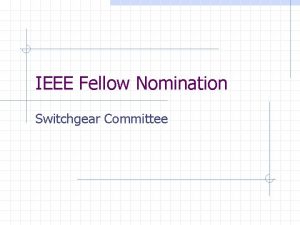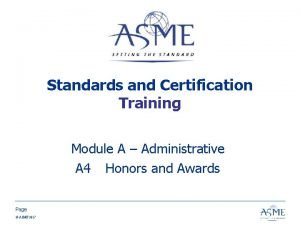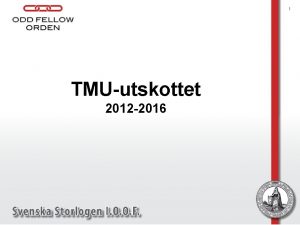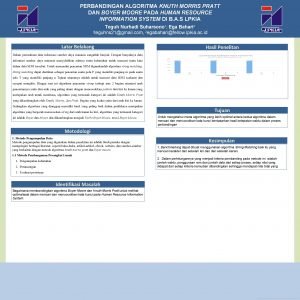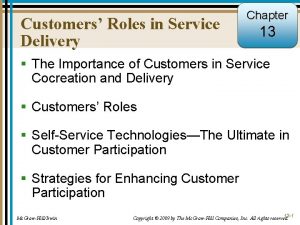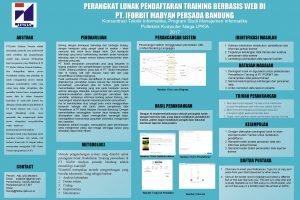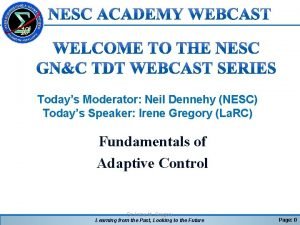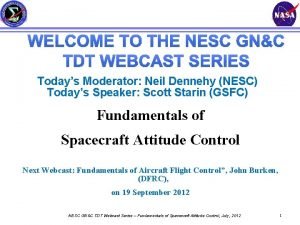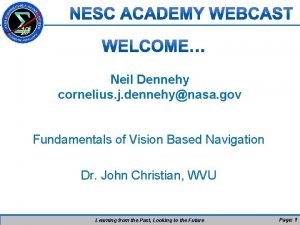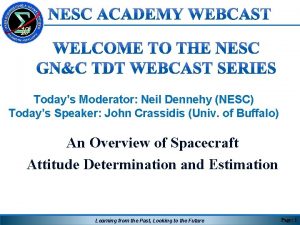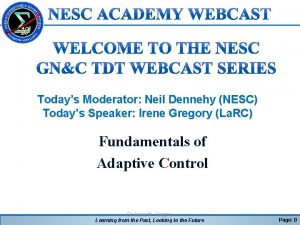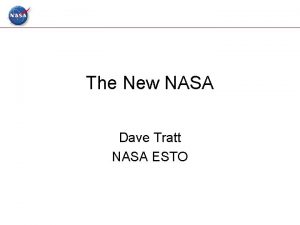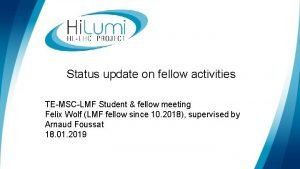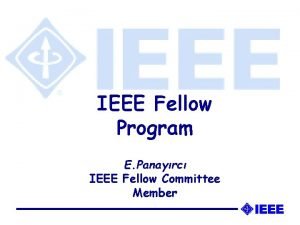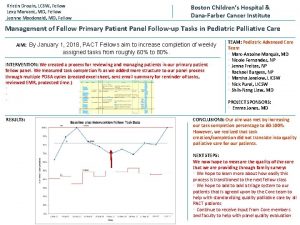Welcome Neil Dennehy NASA Technical Fellow for Guidance
























































- Slides: 56

Welcome… Neil Dennehy NASA Technical Fellow for Guidance Navigation & Control cornelius. j. dennehy@nasa. gov X-15 Flight 3 -65 -97 Accident Analysis: A Fresh Look at the Role of the MH-96 “Self-Adaptive” Flight Control System Presented by: Dr. Jeb Orr The Charles Stark Draper Laboratory, Inc. Learning from the Past, Looking to the Future

Learning from the Past, Looking to the Future

X-15 Flight 3 -65 -97 Accident Analysis: A Fresh Look At The Role of the MH-96 “Self. Adaptive” Flight Control System Jeb S. Orr, Ph. D. The Charles Stark Draper Laboratory, Inc. jeb. orr@nasa. gov NESC Request No: TI-13 -00847 3

The X-15 Research Aircraft • The X-15 research airplane was a manned hypersonic vehicle developed by NASA/USAF/USN and operated by NASA from 1959 -1968 – Designed as a platform for high-speed, high-altitude research – Suborbital, ballistic flight to 350, 000 ft, Mach 6. 7; the first reusable space plane – Supported development of numerous new technologies, including propulsion, instrumentation, structures, TPS, and flight controls • X-15 program conducted 199 research flights over 10 years – Four major accidents, 1 fatal X-15 56 -6672 in flight NESC Request No: TI-13 -00847 X-15 internal layout 4

1967 Accident • X-15 -3 (56 -6672) suffered a fatal accident on November 15, 1967 – Maj. Michael J. Adams, USAF – Loss of control caused in-flight breakup of airframe – Partly due to failure (LCO) in MH-96 “self-adaptive” control system – A joint NASA/USAF IB documented the accident in early 1968; however, IB report has some shortcomings – Causes of the accident not well-understood in the community and not accurately reported in the open literature • NASA engaged in a research effort to thoroughly understand the causes of the accident, especially as they relate to the flight control system • The support of Mr. Neil Dennehy (NESC), Dr. Immanuel Barshi (NASA ARC), Dr. Irv Statler (NASA ARC), Eamonn Moyer (MSFC Summer Intern) and Lauren Massey (MSFC Summer Intern) is gratefully acknowledged NESC Request No: TI-13 -00847 Maj. Michael J. Adams, USAF 5

Flight 3 -65 -97 Accident Summary (I) • • “Routine” altitude flight, 65 th flight of X-15 -3 and 191 st flight of program Planned 250 kft altitude and 5100 fps • • Pilot’s 7 th X-15 flight and 3 rd flight in #3 airframe (relatively new X-15 pilot) Required tracking task using Precision Attitude Indicator (PAI) near peak altitude (high gain task) • Launch 10: 30: 07 PST, power-on sideslip during boost to β=5 deg (TV misalignment) • Poor radio communications (typical) • Electrical disturbance from on-board shock geometry experiment begins 10: 31: 28 – Causes malfunction of IFDS (inertial computer), MH-96 gain changer electronics – Pilot notes IFDS malfunction and attempts reset; unable to reset; acknowledged by ground controllers – Ground notes control anomaly, does not advise pilot or terminate science – Instrumentation, flight control servos, and RCS electronics malfunction NESC Request No: TI-13 -00847 6

Flight 3 -65 -97 Accident Summary (II) • • Pilot attempts to execute planned wing-rock maneuver and aircraft exhibits poor control response Aircraft starts slow yaw drift to right; pilot exhibits apparent mode confusion (roll vs. yaw instrument) Aircraft rates increasing; pilot attempts control using manual RCS override (left-hand stick) at 10: 33: 05 Aircraft enters hypersonic spin at ~10: 33: 32; pilot reports, “I’m in a spin” at 10: 34: 02 Spin recovery by 10: 34: 38 into inverted dive; FCS resets at least twice (gyro rate reset & electrical faults) FCS begins large-amplitude pitch LCO, M=4. 5, q=140 psf LCO prevents pitch recovery; ± 15 g Nz, qβ exceeded, breakup at 62 kft, q=1300 psf, MET +00: 04: 47 Last Full Cockpit Frame Master caution illuminated ADI depicts inverted dive Limit Cycle Oscillation (LCO) Before Breakup ADI in PAI mode MH-96 still engaged RCS set to AUTO NESC Request No: TI-13 -00847 7

What happened? • At >90, 000 feet altitude (prior to engine shutdown), traverse probe experiment in starboard wing pod exhibited low-pressure gas dielectric breakdown and introduced +300 V spikes in at least one aircraft AC power bus – Behavior was reproduced after the accident using reconstructed hardware – Experiment builders used an off-the-shelf motor not knowing it contained a step-up transformer yielding potentials of 630 V peak @ 400 Hz over a 0. 25” gap – Minimum (Paschen) breakdown voltage at X-15 altitudes is only 230 V @ 400 Hz – Traverse probe had been flown twice before on airframes #1 and #2, but on lower-altitude flights and was assumed “qualified” – Altitude testing was not performed • Power irregularity caused numerous system anomalies: – TM noise & communications system interference – ALERT (boost guidance) computer failure – Servo transients (known problem!) – Servo rate monitor disconnects (tripped MH-96 hardover monitors) – Gain changer electronics malfunction (gain-down behavior and reduction in gain-up rate) – IFDS computer resets and gross error in inertial estimates of altitude, altitude rate, velocity, angle of attack, and sideslip • IFDS computer was known to have a susceptibility to EMI NESC Request No: TI-13 -00847 8

What happened? • RCS rate damping and access to the RCS from the RH controller became intermittent – A combination of servo transients and noise caused the MH-96 gain changer to falsely detect a high dynamic pressure condition, and gains were repeatedly reset to their minimum values – When FCS disengages (damper resets) occurred, the system was also designed to set gains to minimum to mitigate transients (false positives on failure detect circuits) – Each time the gain was reset, the RCS was disengaged with no indication given to the pilot • Ground control recognized but did not inform the pilot the subsystem anomalies and furthermore advised the pilot that he was “on heading” meaning on track (no heading information was available to the controller) Ground control advised the pilot to switch to a known erroneous source of sideslip information • • • The pilot was coming “over the top” in a high stress/workload situation, possibly spatially disoriented The pilot recognized a control problem with the auto RCS and switched to manual control using the left stick – The pilot did not disable the automatic system, as per procedure • The pilot experienced apparent mode confusion and attention tunneling caused by a poor ADI design – Having switched the vertical ADI needle from yaw to roll mode, the pilot made control inputs consistent with having interpreted the roll needle as yaw – These inputs exacerbated the sideslip deviation – Two other instruments in the vicinity of the ADI were correctly displaying off-scale aircraft nose right NESC Request No: TI-13 -00847 9

What happened? • Upon recognition that the aircraft rates were increasing, the pilot attempted to arrest the rates but the aircraft entered a hypersonic spin • The pilot and/or aerodynamic stability of the aircraft recovered the spin into an inverted dive at 100 kft • The electrical disturbance ceased, probably due to severing of 2 A line fuses supplying the traverse probe motor • The combination of high gain, large inputs, and violent dynamics introduced a rate-limit instability (large amplitude LCO) into the pitch SAS-servo-power actuator inner loop – The rate-saturated control surface oscillations prevented recovery of the aircraft attitude in pitch or roll • Aircraft structural limits were exceeded as dynamic pressure increased on entry • Pilot did not successfully eject NESC Request No: TI-13 -00847 10

X-15 -3 Flight Control • • • Vertical stabilizer with all-moving rudder; all-moving horizontal tail; wing flaps; speedbrakes Ventral fin used for engine TV misalignment mitigation but removed in 1963 (also eliminated unstable entry lateral-directional mode) Hydraulically actuated surfaces with mechanically interlinked pilot power-assist Differential stabilators for roll control 2 sets of 110 lbf RCS (“BCS”) monopropellant jets NESC Request No: TI-13 -00847 11

X-15 -3 Adaptive Flight Control System • • Airframe #1 and #2 used a conventional fixed-gain (pilot-selectable) 3 -axis SAS Airframe #3 used an experimental adaptive FCS, the Honeywell-developed MH-96 • MH-96 design goals: – Provide automatic blending of RCS and aerosurfaces during exit and entry – Provide invariant response at all flight conditions without air data or gain scheduling – Overcome limitations of predicting aerodynamic parameters • The MH-96 was a relatively advanced form of forward gain adaptive control – Modulate the loop gain of the otherwise fixed-structure SAS inner loop to maximize performance while maintaining stability – Maintain a limit cycle of a prescribed amplitude in the loop at the maximum forward gain NESC Request No: TI-13 -00847 12

MH-96 Design • Small amplitude servoactuator LCO was recognized to be nearly invariant with respect to flight condition (typ. 2 -4 Hz) – Loop shape could be maintained with filters for nearly constant phase margin – Adaptive law modulates the inner loop gain to maintain an LCO set point amplitude – Adaptive gain provides invariant response as the effective loop gain varies with Mach number, dynamic pressure, etc. – “Model” is a 1 st-order LPF – Other than filters, inner loop of SAS is identical to fixed-gain system NESC Request No: TI-13 -00847 13

X-15 RCS and the MH-96 • • Dual-string monopropellant 3 -axis RCS system (110 lbf jets) #1 and #2 airframes had an auto RCS system (reaction augmentation system or RAS) – Rate damping mode only (single-string jets) – Engaged/disengaged manually by the pilot during the ballistic phase – Controlled by LH stick (dual-string jets) – pilot could override auto system • The MH-96 added two major features – Hold modes (based on IMU attitude reference and/or alpha/beta reference) – Automatic engage/disengage of the RCS (“R/C AUTO”) based on adaptive gain level with control through the RH stick • The “R/C AUTO” mode was well-liked; it increased attitude control accuracy, reduced propellant expenditure, and decreased pilot workload • X-15 -3 was used primarily for altitude flights due to increased reliability and decreased pilot workload associated with the MH-96 NESC Request No: TI-13 -00847 14

MH-96 Design Issues (Human Factors) • Pilot display of MH-96 behavior was substantially absent from the design – No indication of “R/C AUTO” engage/disengage provided to the pilot – Initial location of MH-96 status panel could not be seen by the pilot with head restraint – Mechanical interlink with the pilot was problematic • Multiple features developed and tested forward legacy to future missions (e. g. X-20) that were unused by X-15 pilots but remained in the design (multiple hold modes, display modes) • Markedly complex human interface to the flight control system – Partly driven by putting the MH-96 “on top of” an existing manual-hydraulic SAS/FCS • Design was such that a malfunction could prevent access to a critical control function without the pilot’s knowledge NESC Request No: TI-13 -00847 15

MH-96 Design Issues (Flight Control) • • Actual hysteresis effects exceeded those provided to Honeywell for design – Lowered LCO frequency and allowed brief periods of supercritical operation Coupling from RCS firings and pilot inputs reduced the gain, causing RCS disengages – This led to the inclusion of the wide hysteresis band on the engage logic Unexplained servo transient anomalies appeared in flight, probably due to EMI – This was never resolved as it was considered a benign behavior – Caused channel tripouts due to false positive detection in failure monitor circuits – In both cases, system was designed to delay “up” adaptation to suppress transients The MH-96 inner loop had a latent design error resulting in an unstable large-amplitude LCO – This LCO destroyed the aircraft on flight 3 -65 – The causes have apparently never been fully understood NESC Request No: TI-13 -00847 16

MH-96 Large Amplitude LCO (I) • In May 1960 a severe high-frequency SAS LCO was discovered on airframe #2 – 12 -13 Hz oscillation involving servoelastic coupling of the stabilators (TWD effect) – NASA FRC maintained the SAS for the fixed-gain airframes – FRC redesigned the fixed-gain SAS filters to mitigate the LCO and successfully installed and verified the filter change using the HWIL sim and flight tests – No further problems with the 13 Hz LCO were seen on airframe #1 and #2 • MH-96 still in development at this time – FRC sent a basic model of the structural dynamics to Honeywell for evaluation – Honeywell concluded that a redesign of their inner loop would also be required and created their own notch filter to mitigate the issue – The first flight of the MH-96 was scheduled for December 1961 and the FCS was in the final hardware qualification stages – A filter modification was rushed for inclusion in the MH-96 design (hardware filters) • FRC used a nonlinear model of the actuator, Honeywell did not – Honeywell did not evaluate the nonlinear effects or fully regression test the modification NESC Request No: TI-13 -00847 17

MH-96 Large Amplitude LCO (II) NASA FRC Model of Power Actuator (excluding servo) Linear Versus NL Model (rate saturated, 15 deg input) Honeywell Model Rate and servo saturation causes a substantial change in the ideal frequency response characteristics of an actuator NESC Request No: TI-13 -00847 18

MH-96 Large Amplitude LCO (III) • Result: the SAS inner loop of the MH-96 was unstable under saturation at certain flight conditions – Resulted from coupling of the airframe short period pitch mode (~0. 5 Hz) with the actuator dynamics when the actuators were rate saturated (a classic case in PIO) – Although FRC had demonstrated the analysis process for predicting this type of LCO on the other aircraft, they did not analyze the MH-96 inner loop because it was not “owned” by FRC – FRC was aware of this problem, having discovered it in simulation as early as 1962 and in-flight in 1965, but seldom saw it in actual mission simulation • HWIL simulator was not usually run at full flight hydraulic pressures • Unlike previously thought, the inner-loop unstable design is not directly related to the adaptation mechanism – Adaptation exacerbated the onset of the problem by amplifying the forward gain, tending to allow large pilot inputs to saturate the actuator in rate – The same LCO would have resulted on the fixed-gain airplane had the same filter been used, or if adaptation was disabled (verified through analysis and simulation) – The AIB deemed that no further analysis was necessary since the MH-96 had been destroyed NESC Request No: TI-13 -00847 19

Flight and Historical Simulation Data • Based upon available technical reports, the MH-96 large-amplitude LCO phenomenon was known by the end of 1962 and occurred in flight in 1965 (flight 3 -39) “When a large … command is made, rate limiting occurs and causes [a] greatly deteriorated response… nonlinearities in system components cannot be ignored in high-gain control systems. ” – Honeywell was consulted after 3 -39 and recommended avoiding the problematic flight conditions and to “brief pilots on the potential consequences of abrupt control motions…” [AIB] L. Taylor report/conference paper (1962) NESC Request No: TI-13 -00847 1967 Accident 20

MH-96 Simulation • Nonlinear time-domain simulation of airframe + actuator + MH-96 confirms prediction of LCO – LCO initiated by large stick input (cause rate saturation) at critical flight condition Adaptive ON, increasing qbar • Adaptive OFF, fixed qbar Articles in the open literature (IEEE Control Sys. Magazine) erroneously report that the adaptation is the cause of the failure – Discussions with authors reveal that these simulations did not use a rate-limited actuator or a servo model NESC Request No: TI-13 -00847 21

MH-96 Large Amplitude LCO (IV) • A well-known modern extension to DF analysis, called Exact Sinusoidal Inverse Describing Function (SIDF) analysis, can be used to predict instability due to rate limited actuators – Numerical computation of Fourier coefficients associated with DF – Multi-variable problem • Possible two-stage instability – Initial power actuator LCO ~1. 8 Hz – Pitch limit cycle ~0. 58 Hz • Coincidentally, the benchmark case for SIDF analysis is the X-15 -1 landing PIO – Same actuator, similar problem – See Klyde et. al, JGCD NESC Request No: TI-13 -00847 22

Preliminary Summary Recommendations (I) 1. Actuator nonlinearity. – Explicitly account for saturation, rate limiting, and other nonlinear behavior in design. – Exercise regions outside of the expected flight envelope to include cases that induce these behaviors. 2. Modifications to fielded systems. – Modifications should be reconciled with the original design methodology. – Deficient or poorly flight-correlated results should be resolved and documented. 3. Arc discharge. – Arc discharge may be more relevant for ballistic spaceplanes than other systems. – Scrutinize any systems with component voltages above ~60 V, and assess risk. – Testing is mandatory in flight-like pressure, thermal, and radiation environments. – Departures from the ideal theory, including frequency, wave shape, gas composition and temperature, external radiation, electrode composition, and electrode geometry, should be considered in the evaluation of the design. – Applicable standards and handbooks should be utilized (e. g. NASA-HDBK-4002 A). NESC Request No: TI-13 -00847 23

Preliminary Summary Recommendations (II) 4. Flight anomalies. – Seemingly benign anomalies may point to major design flaws. – Low-level engineers must be engaged and have a medium to report concerns. – Flight operations should not continue based on rationale that “it didn’t break last time. ” 5. Availability of safety-critical information to ground control. – For flights involving any experimental systems, all information affecting safety-critical systems and flight dynamics parameters should be available to ground control. 6. Mission operations procedures. – Prevent the formation of an “operational” and “routine” culture. – Flight controllers must be trained that there are no negative consequences to discontinuing a mission if a threat to safety of flight is suspected. 7. Design of pilot-aircraft interface, training procedures, simulations – Instrument modes and FCS automation must be communicated to the pilot. – Train what you fly, fly what you trained. – Design the interface for average humans, even if it will be operated by astronauts. NESC Request No: TI-13 -00847 24

Selected References 1. D. Jenkins, X-15: Extending the Frontiers of Flight. No. SP-2007 -9 -001 -HQ, NASA, 2007. 2. M. Thompson and J. Welsh, “Flight Test Experience With Adaptive Control Systems, ” tech. rep. , NASA Flight Research Center, 1970. 3. “Investigation of the Crash of The X-15 -3 Aircraft on November 15, 1967, ” NASA/USAF Accident Investigation Board Final Report, January 1968. 4. L. Taylor and J. Smith, “An Analysis of the Limit-Cycle and Structural-Resonance Characteristics of the X-15 Stability Augmentation System, ”Tech. Rep. TN D-4287, NASA Flight Research Center, December 1967. 5. D. Klyde, D. Mc. Ruer, and T. Myers, “Pilot-Induced Oscillation Analysis and Prediction with Actuator Rate Limiting, ” Journal of Guidance, Control, and Dynamics, vol. 20, no. 1, pp. 81 -89, 1996. NESC Request No: TI-13 -00847 25

QUESTIONS ? ? ? Learning from the Past, Looking to the Future

UPCOMING NESC GN&C WEBCAST Implementation Challenges for Multivariable Control: What You Did Not Learn in School Dr. Sanjay Garg Wednesday, June 18 th 2 PM EDT Learning from the Past, Looking to the Future Page: 27

BACKUP NESC Request No: TI-13 -00847 28

Dielectric Breakdown Phenomena • • Low pressure dialectric breakdown can readily occur in suborbital flight conditions The X-15 traverse probe motor voltage exceeded the predicted breakdown voltage by ~2 X Approximate motor voltage X-15 Coast Flight Regime 90 kft altitude 1 cm gap Breakdown voltage (~230 V) 90 kft 250 kft *Data is for 300 K, not ambient temp at altitude *Data is for parallel plates; high, non-uniform field intensities (pointed electrodes) will yield lower breakdown voltages NESC Request No: TI-13 -00847 29

Pilot Performance (I) • • Pilot performance during the flight was consistent with Maj. Adams’s experience as a research pilot and his exceptional qualifications (1 st in class USAF ETPS, 1963) The pilot exhibited signs of negative transfer, attentional tunneling, and reversion to basic training in the high stress, task saturated environment – The pilot was presented with multiple failed instruments, none of which he had any reason to believe – The ground exacerbated the situation The pilot mistakenly flew the roll needle as yaw, despite having three working instruments in the same field of view (ADI ball, beta indicator*, heading indicator) – Lack of mode indication on the ADI instrument Maj. Adams did not disengage the AFCS as per procedure when transitioning to the LH stick – Verification of MH-96 disconnect was part of the in-flight analyzer check • May have been skipped; no mention on transcript NESC Request No: TI-13 -00847 PAI needle ADI ball Heading indicator 30

Pilot Performance (II) • The AIB (and subsequent analyses) have speculated that the pilot experienced spatial disorientation (then called “pilot vertigo”) based upon the pilot’s history of “labyrinth sensitivity” – Somatogravic/oculoagravic illusions during 3. 5 g boost – Maj. Adams had previously commented on persistent Type II SD – There is no conclusive evidence supporting the hypothesis that Maj. Adams was disoriented at least until he came over the top – His performance is consistent with belief that aircraft was OK and generally at the correct attitude • AIB suggested that the pilot could recognize the adverse yaw rate visually – During critical period, aircraft was pitch up; only black sky visible – Pilot unlikely to detect ~1 dps yaw rate at 250, 000 feet by visual reference to the horizon* • The pilot was task saturated and dealing with a severely malfunctioning and unresponsive aircraft The pilot was aware that only 60 -90 seconds were available to resolve the problem • NESC Request No: TI-13 -00847 31

Pilot Training and Other Hypotheses • • A review of Maj. Adams training records revealed that less than 20% of his logged simulator time was spent in the #3 aircraft configuration – The potential for negative transfer exists given the substantial differences in the #3 aircraft versus the #1 / #2 aircraft (no MH-96, different panel and instrumentation) Aircraft Hours of Training Percentage X – 15 – 1 165. 2 ~ 69% X – 15 – 2 / X – 15 A – 2 25. 5 ~ 11% X – 15 – 3 47. 5 ~ 20% There is some speculation that an O 2 regulator or supply failure may have caused hypoxia and degraded the pilot’s performance – O 2 system was mostly destroyed on impact – AIB flight surgeon deemed the analysis inconclusive NESC Request No: TI-13 -00847 32

Backup: MH-96 Architecture • Architecture designed to provide fail-safety & redundancy for critical entry phase – Independent dual-string architecture: two sets gain changer electronics, gyros, stick force transducers, accelerometers, etc. – Total gain was sum of both channels at the servo – System could down-mode to fixed-gain operation on pilot request – At time of design, airframe was unstable during entry and drove 99%+ reliability – Design complied with applicable MIL-STDs for airborne electronics (in 1960) • Monitor circuits included to detect and isolate failures – Servo outputs compared to analog model and disconnected if spurious motion detected (difference in sign of surface rate) – Gyro monitor disconnected rate gyro channel if rate exceeded 30 deg/sec • Mechanical override – MH-96 was not fly-by-wire (this would come later with the F-8 DFBW) – MH-96 servos were in parallel to the mechanical links to the power actuators – Pilot brute force could override servo motion and trim actuator motion NESC Request No: TI-13 -00847 33

Aircraft Configuration • • Three airframes in service (56 -6670 – 56 -6672), 56 -6672 (#3) involved in 1967 accident Aircraft varied substantially over course of program – Changes in instrumentation, display panels, avionics, experiments, etc. • X-15 -3 (56 -6672) – High-altitude (ballistic) workhorse (others used for high-speed flights) – MH-96 “Self-Adaptive” flight control system (AFCS) provided automatic RCS blending and invariant aircraft response – Successfully executed 60+ high-altitude flights prior to the 1967 accident – Configuration at time of accident flight will be discussed NESC Request No: TI-13 -00847 34

Flight 3 -65 -97 Event Timeline Approximately 3 minutes NESC Request No: TI-13 -00847 35

Backup: Flight Instrumentation on X-15 -3 (excluding research instrumentation) • • 3 -axis IMU and Inertial Flight Data System (IFDS) – Used to provide pilot estimates of altitude, altitude rate, velocity – IFDS computed inertial solution; IMU drove ADI ball directly – IFDS computer had documented susceptibility to EMI Flight control rate gyros – Two independent, redundant rate gyro assemblies (unique to X-15 -3) – Strapdown (body rate), used for stability augmentation only – Failure monitor circuit zeroed gyro if rates exceeded 30 deg/sec; no pilot indication Hypersonic flow direction sensor (ball nose) – Null-seeking spherical flow sensor – Provided reliable α, β, q to ~50 psf; still usable below 50 psf but with jet interaction effects Flight control accelerometers – Strapdown package for Nz, Ny feedback – Nz feedback used for entry g-limiting NESC Request No: TI-13 -00847 36

Spatial Disorentiation • TYPES OF SPATIAL DISORIENTATION – TYPE I (UNRECOGNIZED) • 9 -3. In type I SD, an aviator does not perceive any indication of SD or think anything is wrong. What the aviator sees—or thinks he or she sees—is corroborated by other senses. The pilot might see the instruments functioning properly and have no suspicion of instrument malfunction. Likewise, the aircraft might be performing normally with no indication of aircraft control malfunction. Unaware of a problem, the pilot fails to recognize or correct the SD, a mistake that usually results in a fatal aircraft mishap. Type I SD is the most dangerous type of disorientation. An example is the height/depth perception illusion, where a pilot descends into the ground or some obstacle above the ground due to a lack of situational awareness. – TYPE II (RECOGNIZED) • 9 -4. In type II SD, the pilot perceives a problem resulting from SD but might not recognize it as SD. The pilot might feel a control is malfunctioning or perceive an instrument failure as in the graveyard spiral, a classic example of type II SD. The pilot will not correct aircraft roll as indicated by the attitude indicator because his or her vestibular indications of straight-and-level flight are so strong. – TYPE III (INCAPACITATING) • 9 -5. In type III SD, the pilot experiences such an overwhelming sensation of movement that he or she cannot orient using visual cues or the aircraft instruments. Type III SD is not fatal if the copilot can gain control of the aircraft. US Army Training Circular No. 3 -04. 93 (FM 3 -04. 301) “Aeromedical Training for Flight Personnel” NESC Request No: TI-13 -00847 37

Backup: Flight Data (Reconstructed) • • Flight data reconstructed from original strip chart recordings Some parameters (Mach, qbar) were not extracted with sufficient fidelity and are reproduced from trajectory data and the 1976 standard atmosphere Most raw data digitization completed by L. Massey (2013 Fall Intern, MSFC) Additional estimation and timecorrelation by E. Moyer (2013 Fall Graduate Intern, MSFC) Data interpolated and uniformly sampled at 10 Hz Noise filtering 2 th order LPF (fc = 1 Hz), forward-backward filtered *MET referenced to ignition NESC Request No: TI-13 -00847 38

Backup: Reconstructed Flight Data • Reconstructed data from TM’d stripchart recording of IMU resolver angles LCO stops • AIB post-correlated IMU data to recovered video footage of sun angle from onboard cameras Wing rock Inverted attitude • MET referenced to ignition • Spin entry at ~10: 33: 22 based on cockpit sun angle • 360 deg wrapping of yaw data is attenuated due to filtering effects LCO starts Ignition Lo. V • Pilot recognition of failure until aircraft demise: ~45 sec Spin recovery Spin begins Heading deviation NESC Request No: TI-13 -00847 39

Backup: Flight Data NESC Request No: TI-13 -00847 40

Backup: Flight Data NESC Request No: TI-13 -00847 41

Backup: Flight Data NESC Request No: TI-13 -00847 42

Backup: Flight Data NESC Request No: TI-13 -00847 43

Backup: MH-96 Simulation • MH-96 model reproduces flight adaptation behavior for nominal and off-nominal qbar profiles Typical entry (flight data) Normal adaptation response NESC Request No: TI-13 -00847 44

Backup: X-15 Simulation Facility NESC Request No: TI-13 -00847 45

Backup: X-15 AFCS Simulink Model (Base) NESC Request No: TI-13 -00847 46

Backup: X-15 AFCS Simulink Model (MH-96/Servo) NESC Request No: TI-13 -00847 47

Cockpit Video (Retimed) • Ignition chamber pressure NESC Request No: TI-13 -00847 48

Cockpit Video (Retimed) • Climb (ADI needles centered) Boost guidance mode active Precision needles centered VV tape hdot>0 NESC Request No: TI-13 -00847 49

Cockpit Video (Retimed) • Computer and instrument malfunction lights on PAI selector switch IFDS computer light IFDS instrument light (flashing) NESC Request No: TI-13 -00847 50

Cockpit Video (Retimed) • Pilot switches ADI to PAI (5 sec after prior frame) PAI mode on NESC Request No: TI-13 -00847 51

Cockpit Video (Retimed) • Pilot attempts IFDS computer reset IFDS reset depressed NESC Request No: TI-13 -00847 52

Cockpit Video (Retimed) • Pilot selects computed (IFDS) alpha/beta (light blinks at 50 psf, pilot pauses at light for ~7 sec) Computed alpha/beta mode light NESC Request No: TI-13 -00847 53

Cockpit Video (Retimed) • MH-96 damper disengage MH-96 reset warning light NESC Request No: TI-13 -00847 54

Cockpit Video (Retimed) • Near peak altitude Vertical needle near center ADI in PAI mode VV tape is now in error Beta off-scale left IFDS light still on NESC Request No: TI-13 -00847 55

Cockpit Video (Retimed) • Spin entry ADI in PAI mode Sun angle indicates yaw rate IFDS lights still on NESC Request No: TI-13 -00847 56
 Neil dennehy
Neil dennehy Cornelius dennehy
Cornelius dennehy Technical fellow microsoft
Technical fellow microsoft Gillian dennehy
Gillian dennehy George dennehy
George dennehy Indirect guidance techniques
Indirect guidance techniques Anti monson curve
Anti monson curve Kahulugan ng ngayon kakahigin ngayon tutukain
Kahulugan ng ngayon kakahigin ngayon tutukain Calipso data download
Calipso data download The poseidon principles
The poseidon principles Segment routing ipv6
Segment routing ipv6 Paul harris fellow certificate template
Paul harris fellow certificate template Odd fellow orden
Odd fellow orden Honorable chair and fellow delegates
Honorable chair and fellow delegates Ieee fellow nomination
Ieee fellow nomination Asme fellow nomination
Asme fellow nomination Ieee fellow program
Ieee fellow program Odd fellow medlemsregister
Odd fellow medlemsregister Little fellow
Little fellow Fellow lpkia
Fellow lpkia Poor little black fellow
Poor little black fellow Customer contributions and roles in service delivery
Customer contributions and roles in service delivery Fellow lpkia
Fellow lpkia Trish livingston deakin
Trish livingston deakin Wise men three clever are we
Wise men three clever are we Steg för steg rita
Steg för steg rita Fspos vägledning för kontinuitetshantering
Fspos vägledning för kontinuitetshantering Ministerstyre för och nackdelar
Ministerstyre för och nackdelar Claes martinsson
Claes martinsson Sju principer för tillitsbaserad styrning
Sju principer för tillitsbaserad styrning Geometriska former i förskolan
Geometriska former i förskolan Dikt form
Dikt form Nyckelkompetenser för livslångt lärande
Nyckelkompetenser för livslångt lärande Handledning reflektionsmodellen
Handledning reflektionsmodellen Varför kallas perioden 1918-1939 för mellankrigstiden
Varför kallas perioden 1918-1939 för mellankrigstiden Tidbok
Tidbok Vilken grundregel finns det för tronföljden i sverige?
Vilken grundregel finns det för tronföljden i sverige? Jätte råtta
Jätte råtta Verktyg för automatisering av utbetalningar
Verktyg för automatisering av utbetalningar Jag har gått inunder stjärnor text
Jag har gått inunder stjärnor text Plats för toran ark
Plats för toran ark Slyngexcision
Slyngexcision Romarriket tidslinje
Romarriket tidslinje Stig kerman
Stig kerman Strategi för svensk viltförvaltning
Strategi för svensk viltförvaltning Verksamhetsanalys exempel
Verksamhetsanalys exempel Typiska drag för en novell
Typiska drag för en novell Tack för att ni har lyssnat
Tack för att ni har lyssnat Matematisk modellering eksempel
Matematisk modellering eksempel Cks
Cks Läkarutlåtande för livränta
Läkarutlåtande för livränta Shaktismen
Shaktismen Inköpsprocessen steg för steg
Inköpsprocessen steg för steg Påbyggnader för flakfordon
Påbyggnader för flakfordon Egg för emanuel
Egg för emanuel A gastrica
A gastrica Relativ standardavvikelse formel
Relativ standardavvikelse formel
